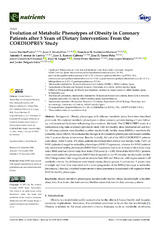Mostrar el registro sencillo del ítem
Evolution of Metabolic Phenotypes of Obesity in Coronary Patients after 5 Years of Dietary Intervention: From the CORDIOPREV Study
| dc.contributor.author | Martín-Piedra, Laura | |
| dc.contributor.author | Alcalá Díaz, Juan Francisco | |
| dc.contributor.author | Gutiérrez Mariscal, Francisco Miguel | |
| dc.contributor.author | Arenas de Larriva, Antonio P. | |
| dc.contributor.author | Romero-Cabrera, Juan Luis | |
| dc.contributor.author | Torres‑Peña, J.D. | |
| dc.contributor.author | Caballero-Villarraso, Javier | |
| dc.contributor.author | Luque, Raúl M. | |
| dc.contributor.author | Pérez-Martínez, Pablo | |
| dc.contributor.author | López-Miranda, José | |
| dc.contributor.author | Delgado-Lista, Javier | |
| dc.date.accessioned | 2021-11-16T13:02:35Z | |
| dc.date.available | 2021-11-16T13:02:35Z | |
| dc.date.issued | 2021 | |
| dc.identifier.uri | http://hdl.handle.net/10396/22127 | |
| dc.description.abstract | Background: Obesity phenotypes with different metabolic status have been described previously. We analyzed metabolic phenotypes in obese coronary patients during a 5-year follow-up, and examined the factors influencing this evolution. Methods: The CORDIOPREV study is a randomized, long-term secondary prevention study with two healthy diets: Mediterranean and low-fat. All obese patients were classified as either metabolically healthy obese (MHO) or metabolically unhealthy obese (MUO). We evaluated the changes in the metabolic phenotypes and related variables after 5 years of dietary intervention. Results: Initially, 562 out of the 1002 CORDIOPREV patients were obese. After 5 years, 476 obese patients maintained their clinical and dietary visits; 71.8% of MHO patients changed to unhealthy phenotypes (MHO-Progressors), whereas the MHO patients who maintained healthy phenotypes (MHO-Non-Progressors) lost more in terms of their body mass index (BMI) and had a lower fatty liver index (FLI-score) (p < 0.05). Most of the MUO (92%) patients maintained unhealthy phenotypes (MUO-Non-Responders), but 8% became metabolically healthy (MUO-Responders) after a significant decrease in their BMI and FLI-score, with improvement in all metabolic criteria. No differences were found among dietary groups. Conclusions: A greater loss of weight and liver fat is associated with a lower progression of the MHO phenotype to unhealthy phenotypes. Likewise, a marked improvement in these parameters is associated with regression from MUO to healthy phenotypes. | es_ES |
| dc.format.mimetype | application/pdf | es_ES |
| dc.language.iso | eng | es_ES |
| dc.publisher | MDPI | es_ES |
| dc.rights | https://creativecommons.org/licenses/by/4.0/ | es_ES |
| dc.source | Nutrients 13(11), 4046 (2021) | es_ES |
| dc.subject | Obesity metabolic phenotypes | es_ES |
| dc.subject | Metabolically healthy obese | es_ES |
| dc.subject | Metabolically unhealthy obese | es_ES |
| dc.subject | Fatty liver index | es_ES |
| dc.subject | Diet intervention | es_ES |
| dc.subject | Mediterranean diet | es_ES |
| dc.subject | Low-fat diet | es_ES |
| dc.subject | Coronary patients | es_ES |
| dc.title | Evolution of Metabolic Phenotypes of Obesity in Coronary Patients after 5 Years of Dietary Intervention: From the CORDIOPREV Study | es_ES |
| dc.type | info:eu-repo/semantics/article | es_ES |
| dc.relation.publisherversion | https://doi.org/10.3390/nu13114046 | es_ES |
| dc.relation.projectID | Gobierno de España. AGL2012-39615 | es_ES |
| dc.relation.projectID | Gobierno de España. AGL2015-67896-P | es_ES |
| dc.relation.projectID | Gobierno de España. PID2019-104362RBI00 | es_ES |
| dc.relation.projectID | Gobierno de España. SAF2017-84135-R | es_ES |
| dc.rights.accessRights | info:eu-repo/semantics/openAccess | es_ES |

